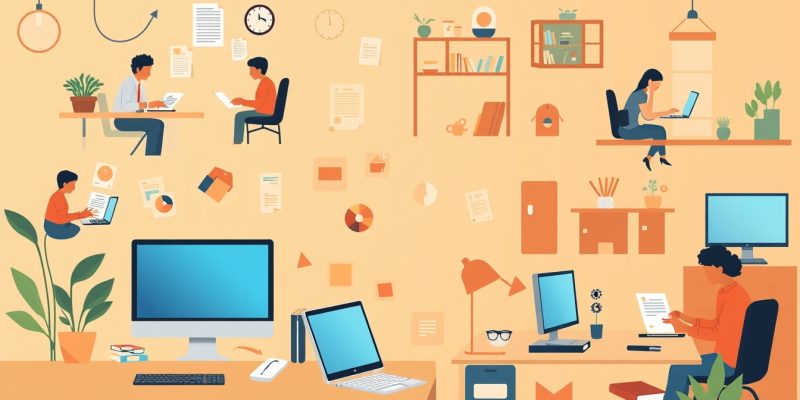In today’s digital age, Personal Computers (PCs) have become indispensable tools for both personal and professional use. They enable a wide range of activities, from simple tasks like browsing the internet to complex operations like software development and graphic design. This article explores what PCs are, their components, types, advantages, and their impact on modern society.
What is a Personal Computer?
A Personal Computer (PC) is a versatile computing device designed for individual use. PCs can perform various tasks, including word processing, gaming, internet browsing, multimedia playback, and software development. They typically consist of both hardware (physical components) and software (programs and operating systems) that work together to execute user commands.
Key Components of a PC
- Central Processing Unit (CPU): Often referred to as the brain of the PC, the CPU processes instructions and performs calculations necessary for running applications and the operating system. The performance of a PC is largely determined by the capabilities of its CPU.
- Motherboard: The motherboard is the main circuit board that connects all components of the PC, including the CPU, RAM, storage devices, and peripherals. It serves as the backbone for communication between different parts of the computer.
- Random Access Memory (RAM): RAM is the computer’s short-term memory, temporarily storing data that the CPU needs to access quickly. More RAM allows for better multitasking and smoother performance when running multiple applications simultaneously.
- Storage Devices: PCs use various storage options, including Hard Disk Drives (HDDs) and Solid State Drives (SSDs), to store data and applications permanently. SSDs are faster and more reliable than traditional HDDs, significantly improving overall system performance.
- Graphics Processing Unit (GPU): The GPU is responsible for rendering images and videos. While many CPUs have integrated graphics, dedicated GPUs are essential for gaming, video editing, and graphic design, providing superior performance.
- Power Supply Unit (PSU): The PSU converts electrical power from an outlet into usable power for the PC’s components. A reliable power supply is crucial for system stability and performance.
- Peripherals: Peripherals include input and output devices, such as keyboards, mice, monitors, and printers, allowing users to interact with the PC and access its functions.
Types of Personal Computers
- Desktops: Desktop PCs are stationary computers designed for use at a desk or workstation. They typically offer more power and storage capacity than portable options and can be customized with various components.
- Laptops: Laptops are portable PCs that combine the functionality of a desktop with the convenience of mobility. They have built-in screens, keyboards, and batteries, allowing users to work on the go.
- Tablets: Tablets are portable touchscreen devices that can perform many functions of a PC. While they may lack the processing power of traditional PCs, they offer a user-friendly interface and are excellent for casual use and media consumption.
- All-in-One PCs: These computers integrate all components, including the monitor and CPU, into a single unit. All-in-One PCs save space and reduce cable clutter, making them ideal for home or office use.
- Gaming PCs: Designed specifically for gaming enthusiasts, gaming PCs are equipped with high-performance CPUs, GPUs, and ample RAM to handle demanding games. They often feature customizable RGB lighting and advanced cooling systems.
Advantages of Personal Computers
- Productivity: PCs enable users to perform a wide range of tasks efficiently, from word processing and data analysis to graphic design and programming.
- Communication: PCs facilitate communication through email, instant messaging, video conferencing, and social media, connecting individuals and teams globally.
- Access to Information: With internet access, PCs provide users with a wealth of information and resources, enabling research, learning, and exploration of diverse topics.
- Entertainment: PCs serve as entertainment hubs, allowing users to play games, watch movies, listen to music, and create content like videos and artwork.
- Customization and Upgrades: PCs can be tailored to individual needs and preferences, with options for hardware upgrades and software installations to enhance performance and capabilities.
The Role of PCs in Modern Society
Personal computers have revolutionized how we work, communicate, and entertain ourselves. In the workplace, they streamline processes and improve productivity, enabling remote work and collaboration across distances. In education, PCs serve as essential tools for research, learning, and online courses, providing access to resources and facilitating communication between students and educators.
Moreover, PCs have transformed personal lives by enabling users to connect with friends and family, explore hobbies, and access entertainment. The growth of the digital economy has also increased reliance on PCs for e-commerce, online banking, and digital content creation.
Conclusion
Personal computers are vital tools that have profoundly impacted modern society. Their versatility, power, and accessibility make them indispensable for personal and professional use. As technology continues to evolve, PCs will likely adapt to meet the changing needs of users, providing innovative solutions and enhancing the way we interact with the world.
Whether for work, study, or leisure, understanding the components and capabilities of personal computers can help users make informed decisions about their technology needs and leverage the power of PCs to improve their productivity and quality of life.
This article provides a thorough overview of personal computers, emphasizing their importance and the various types available, making it a valuable resource for readers looking to understand PCs and their role in contemporary life.
